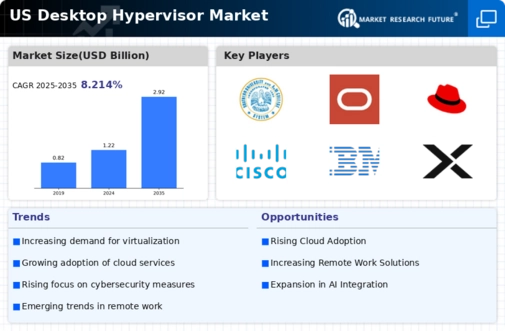Rising Focus on IT Cost Optimization
In the current economic climate, organizations are increasingly prioritizing IT cost optimization, which is driving growth in the desktop hypervisor market. By consolidating hardware resources and utilizing virtualization, companies can significantly reduce their IT expenditures. This trend is particularly relevant in the US, where IT budgets are under scrutiny. The ability to run multiple operating systems on a single physical machine not only lowers hardware costs but also minimizes energy consumption and maintenance expenses. As a result, the desktop hypervisor market is expected to witness a robust growth trajectory, with estimates suggesting a market value exceeding $5 billion by 2026.
Growing Demand for Remote Work Solutions
The desktop hypervisor market is experiencing a notable surge in demand due to the increasing need for remote work solutions. Organizations across various sectors are adopting virtualization technologies to enable employees to access their work environments from anywhere. This trend is particularly pronounced in the US, where a significant % of the workforce is now working remotely. The flexibility and efficiency offered by desktop hypervisors allow companies to maintain productivity while reducing operational costs. As businesses continue to invest in remote work infrastructure, the desktop hypervisor market is likely to expand, with projections indicating a potential growth rate of over 15% annually in the coming years.
Advancements in Virtualization Technologies
Technological advancements in virtualization are playing a crucial role in shaping the desktop hypervisor market. Innovations such as improved performance, enhanced user interfaces, and better integration with existing IT infrastructures are making desktop hypervisors more appealing to businesses. In the US, the introduction of features like GPU virtualization and support for high-performance applications is attracting a diverse range of industries. These advancements not only enhance the user experience but also enable organizations to leverage virtualization for critical applications. Consequently, the desktop hypervisor market is poised for growth, with a projected CAGR of around 12% over the next five years.
Increased Regulatory Compliance Requirements
The desktop hypervisor market is also influenced by the rising regulatory compliance requirements faced by organizations in the US. Industries such as finance, healthcare, and government are subject to stringent regulations regarding data security and privacy. Desktop hypervisors provide a means to create secure, isolated environments for sensitive data, thereby assisting organizations in meeting compliance mandates. As businesses strive to adhere to these regulations, the demand for desktop hypervisors is likely to increase. This trend may lead to a market expansion, with estimates indicating a potential increase in market size by approximately 10% annually as companies invest in compliant virtualization solutions.
Growing Interest in Disaster Recovery Solutions
The increasing awareness of the importance of disaster recovery solutions is driving growth in the desktop hypervisor market. Organizations in the US are recognizing the need for robust backup and recovery strategies to safeguard their data and ensure business continuity. Desktop hypervisors facilitate the creation of virtual machines that can be easily backed up and restored, making them an attractive option for disaster recovery planning. As businesses invest in these solutions, the desktop hypervisor market is expected to see a significant uptick, with projections suggesting a growth rate of around 14% over the next few years as companies prioritize resilience in their IT strategies.






















Leave a Comment